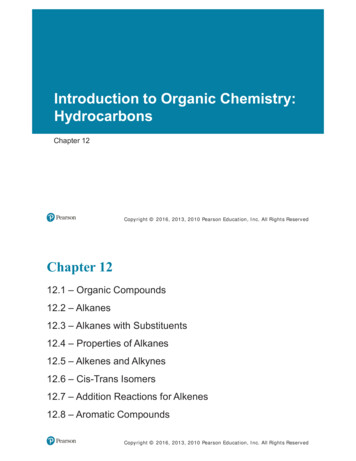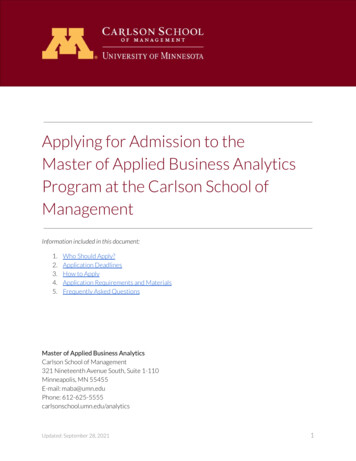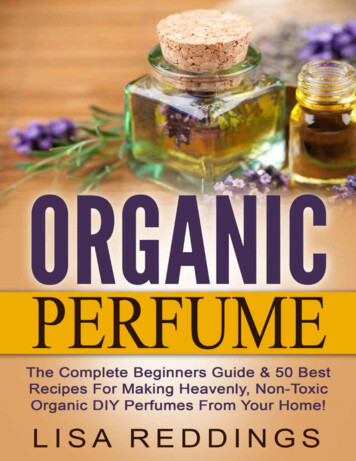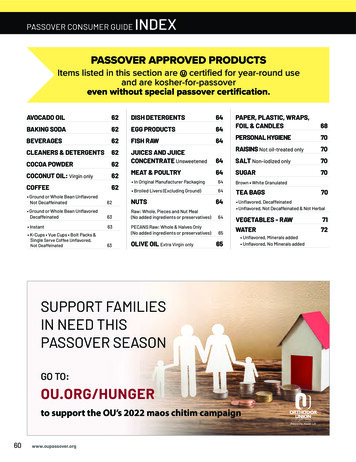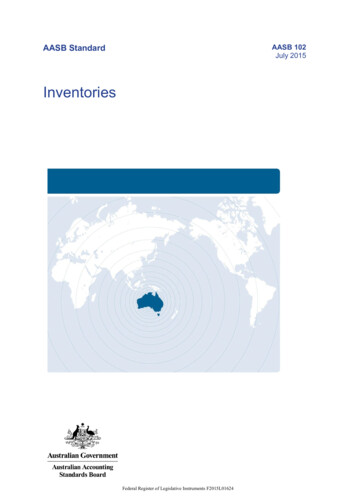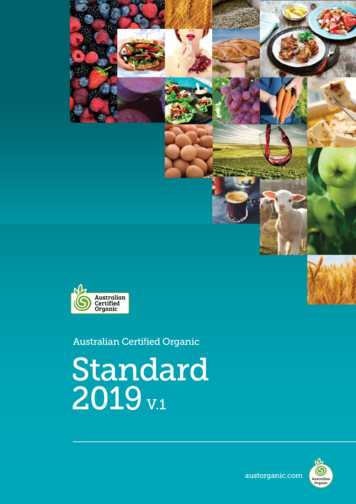
Transcription
Australian Certified OrganicStandard2019 V.1austorganic.com
Table of ContentsTABLE OF CONTENTSTABLE OF CONTENTS11.SCOPE32.DEFINITIONS4CERTIFICATION REQUIREMENTS: GENERAL3.8BASIC CERTIFICATION REQUIREMENTS3.1.CERTIFICATION PROCESS3.2.MAINTAINING CERTIFICATION3.3.NON-COMPLIANCE AND CORRECTIVE ACTION REQUESTS3.4.DOCUMENTS, RECORDS AND AUDIT TRAILS3.5.LABELLING, PACKAGING, MARKETING MATERIAL AND INGREDIENT SPECIFICATIONS3.6.PARALLEL PRODUCTION3.7.CERTIFICATION TRANSFERENCE/RECOGNITION ARRANGEMENTS3.8.DEFERRAL OF CERTIFICATIONSTANDARDS REQUIREMENTS: GENERAL – PRIMARY PRODUCTION4.GENERAL PRODUCTION STANDARD – PRIMARY PRODUCTION4.1.SOIL FERTILITY AND HEALTH MANAGEMENT4.2.BROUGHT-IN MATERIALS, STOCK AND EQUIPMENT4.3.COMPOSTS4.4.WATER MANAGEMENT AND ECOLOGY4.5.PEST, DISEASE AND W EED MANAGEMENT4.6.ENVIRONMENTAL MANAGEMENT AND SOCIAL POLICY4.7.CONTAMINATION: SOILS AND PRODUCE AND BUFFER ZONES8813131516181919202020212223242526SECTOR SPECIFIC VESTOCK PRODUCTION5.1.LIVESTOCK MANAGEMENT – GENERAL5.2.POULTRY – MEAT AND EGG PRODUCTION5.3.PORCINE (PIG) PRODUCTION5.4.DAIRY PRODUCTION5.5.CAPRINE/GOAT PRODUCTION5.6.MISCELLANEOUS INTENSIVE PRODUCTION ENVIRONMENTS5.7.EXTENSIVE RANGELAND PRODUCTIONPROCESSING/PREPARATION6.1.PRODUCTION FACILITIES, PROCESSES & PROCEDURES6.2.ANIMAL PRODUCTS6.3.DURABLE FOODSTUFFS6.4.PERISHABLES (FRUITS, VEGETABLES) & WET PROCESSING6.5.MISCELLANEOUS PROCESSED PRODUCTS6.6.COSMETICS AND SKINCARE PRODUCTS6.7.NATURAL FIBRES / TEXTILESMISCELLANEOUS PRODUCTION SYSTEMS7.1.HONEY AND BEE KEEPING7.2.GREENHOUSES, NURSERIES AND SEED PRODUCTION7.3.SPROUTS INCLUDING W HEATGRASS7.4.MUSHROOMS7.5.WILD HARVEST7.6.SILVICULTURE / FOREST MANAGEMENT7.7.AQUACULTURE7.8.SPECIAL PROJECTS AND GROWERS GROUPS7.9.FAIR TRADE – ETHICAL TRADEMARKETING & HANDLING8.1.RETAIL AND ANTS AND PREPARED FOOD SUPPLIERS8.4.TRANSPORT AND STORAGE OPERATIONS8.5.FARMERS’ MARKETS AND OTHER MARKETSMANUFACTURED INPUTS, AIDS & ADDITIVES AND APPROVED SERVICES9.2.AGRICULTURAL INPUTS – SELECTION CRITERIA9.3.AIDS AND ADDITIVES – SELECTION CRITERIA9.4.APPROVED SERVICES9.5.LABELLING REQUIREMENTS FOR ALLOWED INPUTS AND APPROVED PRODUCTS1 OF 100Australian Certified Organic Standard AO Ltd
Australian Certified Organic Standard 2019 Version 1ANNEXES68EXPLANATION TO ANNEXES FOR CROP AND LIVESTOCK INPUTS & TREATMENTS68ANNEX I: CROP PRODUCTION INPUTS70ANNEX II: LIVESTOCK TREATMENTS & INPUTS76EXPLANATION TO ANNEXES FOR PROCESSING AIDS & ADDITIVES, AND SANITISERS79ANNEX III: PROCESSING AIDS & ADDITIVES80ANNEX IV: CLEANSERS, DISINFECTANTS, AND SANITISERS83ANNEX V: BIODYNAMIC STANDARD85ANNEX VI: ADDITIONAL REQUIREMENTS FOR EXPORTING TO THE EU87ANNEX VII: ADDITIONAL REQUIREMENTS FOR IFOAM CERTIFICATION95ACKNOWLEDGEMENTS99Australian Certified Organic Standard AO Ltd2 OF 100
General Certification Requirements1. SCOPE1.1This Standard outlines the minimum requirements for certification of organic or biodynamicproduce under the ACOS and use of the AO logo.1.2This Standard applies to the following products that carry, or are intended to carry, descriptivelabelling referring to organic production methods or organic certification:a.unprocessed products from plants, animals, cultured organisms and approvednaturally occurring materials (excluding water and salt); andb.processed products derived mainly from (a) above.1.3Products are not compatible with the principles of organic agriculture and are not permittedunder this Standard where they are derived from genetic engineering (GE) practices orproducts, or are treated with ionising radiation for post-harvest purposes, or are fromnanotechnology products and processes.1.4Requirements in this standard are complementary and additional to other health, agricultural,environmental, food and production related regulatory requirements at Commonwealth, State,Territory and other relevant levels. This includes adherence to the Agricultural and VeterinaryChemicals Code Act 1994 and the Australian Pesticides and Veterinary Medicines Association(APVMA), which prescribes registration and exemption requirements.1.5This standard should be read in conjunction with other relevant standards for those planningto export, and additional auditing and certificates may be required for these markets. Notethat for those planning to export, minimum requirements of the importing country alsoneed to be met. Such requirements may be in addition, and sometimes contrary, tothose outlined in this Standard. Onus is on the certified operator to ensure that theseadditional criteria are met for access to those markets.1.6This Standard is current from 1st May, 2019 until such time as a new edition, or amendment,is released under the authority of Australian Organic. All changes to this Standard which differfrom the ACOS 2017 and subsequent amendments of the Standard shall be implementedno later than 30th June 2019 without prior request and acceptance from the certification office(CO).1.7Disclaimer: Note should be taken at all times of amendments to this Standard which mayoccur from time to time. Such amendments will supersede existing respective clauses outlinedin this Standard, with time frames for implementation outlined by the CO, and may occur wherethere are changes to regulatory requirements, technologies or techniques. This is a livingStandard; hence the onus is on the operator to ensure that their practices at all timescomply with the latest requirements outlined. Australian Organic and the CO reserve theright to amend this standard at any time in order to remain compliant with such requirements,whilst also being required to regulate to specific markets which the client may wish to haveaccess, which may entail requirements above or different from the exact details of thisStandard.3 OF 100Australian Certified Organic Standard AO Ltd
Australian Certified Organic Standard 2019 Version 12. DEFINITIONSAdditives: Substances added to a product to affect its inherent quality.Agricultural product: Any product or commodity (excluding water, salt and additives), raw or processed,derived from primary production activities, which is marketed for human consumption or animal feed.Allowed (A): Input that may be used within an organically certified system without affecting certification. AOmaintains a formal register of Allowed Inputs (AIs) and Approved Products (APs) which are registeredproducts having been assessed to comply with requirements outlined in this Standard for use in organicproduction systems.Animal testing: Testing of chemicals to assess safety, efficacy or environmental effects in non-humananimals including vertebrates and invertebrates. Animal testing excludes in vitro tests, use of animal organsfrom animals slaughtered for the meat industry, or tests conducted with human volunteers.Audit: A systematic and functionally independent examination, and reporting to a designated reviewcommittee, to determine whether activities comply with planned objectives and requirements of relevantStandards. This may include unscheduled audits and gap audits. This is also referred to within the organicindustry internationally as an inspection.Auditor: A person deemed by the certification office to have the expertise and authority to inspect and auditoperators in regard to compliance to this Standard for certification purposes. An auditor must have, at aminimum, some or all of the following qualifications: academic degrees;qualifications and experience in farming, food processing, forestry, livestock production, inputmanufacturing; orauditing experience to HACCP, ISO9001, ISO1400.Australian Organic Ltd: This organisation owns and manages the Australian Certified Organic Standard,being a not for profit group, owned by industry members and those with an interest in the organic sector.Australian Pesticides and Veterinary Medicines Authority (APVMA): Federal organisation regulating theuse of agricultural pesticides and livestock treatments for disease and pest control applications.Biodynamic (BD): Production system based upon principles and preparations established by RudolfSteiner.Biological Farmers of Australia Ltd (BFA): This is the prior name of Australian Organic Ltd. BFA originatedin 1987 and changed its name in 2012.Bud logo: The logo owned and registered with IP Australia as a Certification Trade Mark by AO, which isused on products certified to the ACOS,Catalyst: A substance used in small quantities to accelerate chemical reactions without itself being affected.Certified: To have been audited and subsequently licensed by an approved and recognised certifier inaccordance with the Australian Certified Organic Standard.Certification office (CO): Official office of an approved certifier which maintains licence agreements,coordinates audits and assesses ongoing conformance with the Standard.Certification review committee (CRC): Committee within a certification body, which uses audit reports andother means to make decisions regarding certification of operations and properties.Certification transference: Arrangement between certification bodies regarding recognition of anothercertification system and certified products as equivalent for handling and marketing as certified organic.Competent authority: A recognised government agency in a given country charged with managing anorganic compliance program.Compliance: Actions or outcomes which relate to meeting requirements of this Standard or of the operator’sorganic management plan (OMP). Non-compliance is where such actions or outcomes do not meetspecifications of this standard or the OMP.Conventional: Primary production or food preparation which does not conform to the Australian CertifiedOrganic Standard.Conversion: See In conversion to organic.Corrective action request (CAR): Action required by an operator following a non-compliance or systemsdeviation to ensure ongoing certification and compliance to the Australian Certified Organic Standard. Suchactions may be requested by the certifier following noted non-conformance to the Australian CertifiedOrganic Standard.COSMOS: The COSMetics Organic and Natural Standard is an international Standard for organic andnatural cosmetics maintained by COSMOS-standard AISBL, an international non-profit association foundedin June 2010 by five European certification bodies. Note that the requirements for this Standard andAustralian Certified Organic Standard AO Ltd4 OF 100
General Certification Requirementscertification program are specified in a separate text, which the certified operator must obtain and ensurecompliance with, in order to maintain certification with the program. Further details on certification toCOSMOS are available from the certification office.DAWR: (Formerly AQIS) Department of Agriculture and Water Resources – Organic Program. DAWR hasan organic program arm that administers the National Standard for Organic and Bio-Dynamic Produce andaccredits certifiers to this program.Direct source organism: The specific plant, animal or microbe that produces a given input or ingredient, orthat gives rise to a secondary or indirect organism that produces an input or ingredient.Environmental management system (EMS): A system that aims to manage environmental aspects of theoperation.Farm unit: Sections of land fully under the management control of one party or person. There may be morethan one farm unit owned and managed by a single party or operator.FSANZ (Food Standards Australia New Zealand): Food authority that lists maximum residue limits (MRLs)for agrichemicals in or on food and fibre and sets food standards. The Australian Certified Organic Standardis in addition to these requirements.Gap audit: An audit that assesses areas where the operator may require modification to plans or practicesprior to certification or prior to addition of areas or products for certification. Also referred to as a desk audit,such audits may occur either by document review and/or on-site assessment.Genetic engineering (GE): A set of techniques from molecular biology by which the genetic material ofplants, animals, microorganisms, cells and other biological units may be altered in ways or with results thatcould not be obtained by methods of natural mating and reproduction or natural recombination. Techniquesof genetic modification include, but are not limited to: recombinant DNA, cell fusion, and micro and macroinjection. Genetically engineered organisms will not include organisms resulting from techniques such asconjugation, transduction and hybridisation.Genetically modified organism (GMO): A plant, animal, or microbe that is transformed by geneticengineering.Hazard analysis critical control point (HACCP): Management system oriented towards minimising oreliminating hazards posed as part of the production process through means of monitoring and verification.For organic operators, HACCP management implies a system of identification of all significant hazards thatmay compromise an ability to conform to this Standard for organic production, identifying control points,putting in place management practices that help eliminate or reduce risks associated with those hazards,and then maintaining verification processes to ensure that management practices are effective.A hazard for some organic producers may be the potential for chemical overspray from neighbouring farmingactivities or cross-pollination potential from GMO crops. Other hazards may include old dip sites or otherpotentially contaminated areas which may require fencing off or management of stock to ensure restrictionof access. All significant food safety risks shall also require HACCP-based management to be implementedin organic operations.IFOAM: International Federation of Organic Agriculture Movements. IFOAM is the internationalrepresentative organisation for organic agriculture, whilst also setting the IFOAM Basic Standard (IBS) orIFOAM Norms. In addition IFOAM maintains an accreditation program via the International OrganicAccreditation Service (IOAS), which accredits certifiers. IFOAM requirements may be driven by market orbuyer demands or requirements (in addition to government regulations). Operators need to remain aware ofwhat these requirements are and monitor their own marketing needs.In conversion to organic: Period of time prior to full “organic” status being given to an operator and farmunit.Ingredients: All products and aids that constitute or are used in the production of a processed or preparedproduct.Inputs: Materials that are brought onto the farm unit to assist with production.Inspection: See Audit.JAS: The regulatory system applying in Japan and regulated by the Ministry of Agriculture, Fisheries andFood (MAFF) called the Japanese Agriculture System – Organic (JAS). Note that the regulatoryrequirements for that Standard and certification program are specified in a separate text, which the certifiedoperator must obtain, maintain and ensure compliance with, in order to maintain certification to thisregulation.Korean organic certification: South Korea regulations on organic products are based on two differentstandards: Environmental-Friendly Promotion Act (EFAPA) for agricultural produce, and the Food IndustryPromotion Act (FIPA) for processed products. The Ministry for Food, Agriculture, Forestry and Fisheries(MIFAFF) and the Korean Food and Drug Administration (KFDA) accredit certifiers for the inspection andcertification according to both Organic Korean standards. Note that the regulatory requirements for these5 OF 100Australian Certified Organic Standard AO Ltd
Australian Certified Organic Standard 2019 Version 1standards are specified in a separate text, which the certified operator must obtain, maintain and ensurecompliance with, in order to maintain certification to this regulation.Labelling: Any words, particulars, trademarks, brand names, names of certifying organisations, pictorialmatter or symbols appearing on any packaging, document, notice, label or collar accompanying or referringto a certified organic product.Land unit: Section or portion of land as compared with entire farm unit, made up of all land units within thefarm.Level of reporting (LOR): For pesticide and heavy metal residue tests. LOR less than level of reporting.Licence agreement: Legally binding contract between the certification office and operator pertaining toorganic certification.Licensee: Operator and/or owner of operations covered under the licence for organic certification.Manufactured inputs (MI): Physically compounded inputs allowed by certification office under thisStandard.Marketing: Holding or displaying for sale, offering for sale, selling or placing on the market.Maximum permissible concentration (MPC): Maximum concentrations of given substances (heavymetals) allowed in foods as set out by the National Health and Medical Research Council (NHMRC)Australia.Maximum residue limit (MRL): Maximum residues of given substances, such as agrichemicals, allowedon foods as set by Food Standards Australia New Zealand (FSANZ).Mineral/mined mineral: A naturally occurring substance formed through geological processes that has acharacteristic chemical composition.Nanotechnology: Nanotechnology includes the intentional manufacture of material that has one or moredimensions of the order of 300 nm or less or that is composed of discrete functional parts, either internallyor at the surface, many of which have one or more dimensions of the order of 300 nm or less, includingstructures, agglomerates or aggregates, which may have a size above the order of 300 nm but retainproperties that are characteristic of the nanoscale. This does not include the presence in certified organicproducts of naturally occurring nanoparticles, for example from nanoparticles in volcanic soils, orincidentally produced (non-manufactured) nanoparticles, for example occurring in flour as a by-product ofthe traditional milling process.Natural: Any material, not otherwise expressly prohibited in this Standard, which has been harvested,mined, or collected, which may be processed without chemical reaction (allowing washing, distilling,grinding/milling, separation and/or concentration of the material by physical (including steam) or biologicalmeans, to yield a material that is identifiable in the original source material.Operator: Licensee of organic certification licence responsible for management or for delegation ofmanagement for the production unit or units and products listed in the licence agreement.Organic: Production practices that conform to this Standard for production.Organic in conversion: Period of time prior to full “organic” status being given to an operator and farm unit.Organic management plan (OMP): Management plan that outlines production plans to achieve ongoingconformance with this Standard. This may include identification of key management personnel, fertility, pestand disease management plans, documented recording systems and future on-site plans (increasing stocknumbers, new crop types, longer term reduction of inputs, etc.). Such a plan may include a section basedupon HACCP principles (see above), where there are identified potential hazards to the production unit’sorganic certification.For primary production this is known as an organic farm plan (OFP). The OFP may outline buffer zoneestablishment in relation to containing neighbouring chemical overspray risk or potential contamination fromGMO crops. Other identified risks may be brought-in manures or other materials that may require residuetesting or composting, which would be outlined in such a plan. Such a plan forms the basis of certificationand auditing.For processing, preparation or other handling operations, this is known as an organic handling plan (OHP).The OHP would outline management control, audit trail recording systems and related management systemsto be implemented or currently practised to ensure maintenance of certified product authenticity and fullconformance with this Standard.Organochlorines (OCs): Class of conventional agricultural chemicals, typically DDT and Dieldrin,prohibited for use under this Standard and restricted as allowed historic residues on organic farms.Organophosphates (OPs): Class of conventional agricultural chemicals, based upon phosphorus esters,prohibited under this Standard and prohibited as residues on certified organic products.Australian Certified Organic Standard AO Ltd6 OF 100
General Certification RequirementsPrecautionary principle: Principle that states that where there are threats of serious or irreversibleenvironmental damage, lack of full scientific certainty should not be used as a reason for postponingmeasures to prevent environmental degradation. Decisions should be guided by: (i) careful evaluation toavoid, wherever practicable, serious or irreversible damage to the environment; and (ii) an assessment ofthe risk-weighted consequences of various options.Precertification: Period of time – generally a minimum of 12 months – prior to a certification level beingobtained by the operator for land-based primary production systems within Australia. Produce cannot besold with any reference the wording “certified organic” in this period.Preparation: See ProcessingPreventative actions: Actions taken to ensure that procedures are in conformance with the AustralianCertified Organic Standard.Primary ecosystem: Environments that are pristine and have not been disturbed by human activities.Processing: Operations that may consist of handling, altering, preserving, packaging and labelling ofagricultural products.Processing aids: Substances intentionally used in the processing of products to fulfil an essentialtechnological purpose, and which do not exist in the final product in their original form.Production unit: Farm, processing or other commercial entity operated or managed for the purposes offood, fibre or cosmetics production, preparation or handling.Prohibited (P): Substances or practices disallowed under this Standard. This Standard is a positive list,meaning only those substances listed are allowed for use on certified facilities or farm units.Quarantine: The isolation of livestock from the certified area of the farm for a given period.Quarantine area: A dedicated area of the farm that is used for the purposes of quarantine and/or withholdingpractices.Reagent: A substance used to start a chemical reaction.Restricted (R): Input that may be used on a limited basis with verification required by the user as to its needvalue.Standard: In this publication refers to this Australian Certified Organic Standard (ACOS) and subsequentamendments for organic production preparation and marketing. The Standard defines criteria forassessment for certification.Sustainable agriculture: Production system exhibiting resilient ecological and economic characteristics.Transaction certificate: Document that accompanies certified goods outlining type of goods, batch numberor identification, certification status, etc. See 3.4.3.Transport declaration: As for transaction certificate – applicable for bulk commodities (e.g., wheat) andlivestock.USDA NOP: The regulatory system applying in the United States and regulated by the U.S. Department ofAgriculture (USDA) called the National Organic Program (NOP). Note that the regulatory requirements forthis Standard and certification program are specified in a separate text, which the certified operator mustobtain, maintain and ensure compliance with, in order to maintain certification to this regulation. Certificationto USDA NOP is available via USDA-accredited certifiers.Verification: System of assessment used by the CO for attainment or maintenance of certification. Thisincludes, but is not limited to, the audit system, statutory declarations, testing and records and documentsmaintained by the operator.7 OF 100Australian Certified Organic Standard AO Ltd
Australian Certified Organic Standard 2019 Version 1CERTIFICATION REQUIREMENTS:GENERAL3. BASIC CERTIFICATION REQUIREMENTSReference to organic or biodynamic certification and use of the Bud logo requires audit, certification andlicensing via a recognised and independently accredited certifier, and conformance to this Standard. Legalor other means shall be pursued where incorrect or unauthorised use of the Bud logo is found to be occurring.Operators wishing to utilise the Bud logo for organic certified products are required to undertake the stepsoutlined below in section 3 whilst conforming to criteria relevant to their sector: Cropping and Horticulture tosection 4; Livestock to sections 4 and 5; Processing to section 6, etc.Where certification for the EU market is required, operators must also comply with the requirements detailedin Annex VI. The Annex Vl requirements override references in the main text or other annexes, on the sametopic. For example, if a product is listed as allowed in the main text, but is NOT listed in Annex VI for thatspecific use, then the additive is NOT allowed for use in EU certified products.3.1.Certification ProcessApplication or all sectors of certification, the operator makes application to the certification office (CO), andcompletes a Statutory Declaration Questionnaire, supplying all relevant details of theproduction unit’s history, current operations and production output, management details andproduction plans. Application may be made for certification for a given management unit orpart of that unit – which may comprise single ownership and/or single management control.Onus is on the operator and their workforce to ensure at all times that they are fully aware of allrelevant aspects of the Standard as they pertain to their operation, whilst remaining aware ofextra requirements that may be stipulated by other regulators and/or markets, which may bein addition to or different from this Standard. Achievement and maintenance of certification isbased upon active management steps by the certified operator.An application for certification, including payment, shall be made to the CO, and completedocuments submitted for desk review, before an initial site assessment and audit shall bearranged. All documents shall be signed and/or witnessed as required prior to final approval.Certification of a production unit applies to the operator who owns, leases or has legallyrecognised and enforceable management control of such production units or facilities.Certification therefore is not transferable but applies to both the operator and the productionor preparation facilities, farm or area of land certified.Certification of preparation/processing, manufacturing or related facilities may be givenfollowing CO review of the initial on-site inspection. The operator must be able to verifyadherence to the requirements of this Standard and special conditions laid out by the CO inthe licence agreement, while exhibiting effective management control for organic producthandling, preparation and dispatch, as outlined in section 6.For land-based primary production sectors within Australia, prior to certification being granted a12-month period under the audit system, or similar recognised audit system, shall take place– known as precertification. During this period, there shall be an initial (“gap”) audit and at aminimum one full on-farm audit, which will include the assessment of organic managementand the taking of soil and/or tissue samples for the testing of contamination from veterinaryand agricultural chemicals, heavy metals and/or GMOs, etc., where applicable. Such testingmay assess products and processes throughout the production and preparation chain. Duringthe precertification period, labelling of the product shall not make reference to the productionmethod as organic, the certification agency or that the product is under an organic auditingand/or certification system.Prior to auditing, an organic management plan (OMP) shall be established outlining plans toenable ongoing adherence to the Standard, with key reference, where relevant, to HACCPbased plans in the case of identified hazards to organic production or food safety. This planmay be incorporated as part of existing plans and management systems and shall highlightand assist in monitoring and verifying how, through time, the operator is continually improvingthe environmental and productivity outcomes of the operation.For primary production sectors, the organic farm plan (OFP) shall at a minimum addressthe following:Australian Certified Organic Standard AO Ltd8 OF 100
General Certification RequirementsFertility and soil management; Pest, disease and weed management; Biodiversity andenvironmental management; Water management; Contamination prevention management;Record-keeping system including monitoring practices (e.g., for soil fertility, salinity, etc.);and Livestock feed, health and welfare management (where relevant), use of restrictedproducts and regular use of products listed in Annex I and II.For processors and handlers of certified products, the organic handling plan (OHP) shalloutline the products processed/handled; a flow chart of processing or handling activities; allingredients to be sourced with plans outlined to ensure valid certification status, GMO andirradiation-free status; outline of record-keeping system; outline of monitoring practices andprocedures to ensure that the plan is effectively implemented (including regular reviews ofnon-organic ingredients and the non-GMO status of ingredients); other management practicesand personnel responsible to ensure there will be no co-mingling with non-certified productand that organic integrity is maintained. See section 6 Processing/Preparation.3.1.8.For primary producers, following a minimum of one full audit outlined in 3.1.6, the CO shallascertain the d
Standard. . . .
